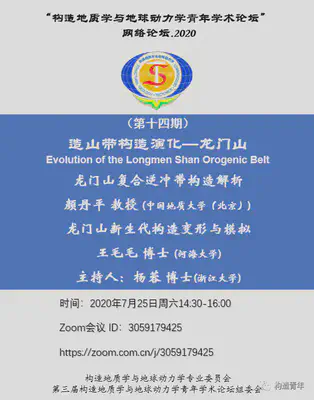Cenozoic Tectonic Deformation and Simulation of the Longmenshan
Course Replay
- geovbox@Bilibili https://www.bilibili.com/video/BV1si4y137DX/
Time: Saturday, July 25, 2020, 14:30-16:00
Zoom Meeting ID: 3059179425
URL:https://zoom.com.cn/j/3059179425
Tectonic Network Forum Session 14: Tectonic Evolution of Orogenic Belts—Longmenshan
- Report 1: Analysis of the Longmenshan Reverse Thrust Belt Structure by Professor Yan Danping, China University of Geosciences (Beijing)
- Report 2: Cenozoic Tectonic Deformation and Simulation of the Longmenshan
- Presenter: Wang Maomao, School of Marine Science, Hohai University
- Content Summary:
- Eastern Tibetan Plateau: Debate on Lower Crustal Flow vs. Upper Crustal Shortening;
- Cenozoic tectonic deformation of the Longmenshan fold-thrust belt;
- Research progress on the simulation of Cenozoic tectonic deformation.
- The numerical simulations used in the report were completed using VBOX;
- The simulation results effectively explain the differential distribution of structural strain in the Cenozoic foreland thrust belt of Longmenshan;
- Experimental design and boundary condition control are worthy of study.
Tectonic physical modeling and numerical simulation can quantitatively analyze the deformation characteristics of fold-thrust belts through accurate boundary conditions and parameter settings. This is an important method for quantifying the deformation processes and mechanisms of fold-thrust belts. Compared to physical modeling, numerical simulation can obtain more information from within the system (such as stress and strain) and has higher reproducibility, with easier boundary condition settings (Li Changsheng, 2019). In the 1970s, Cundall and Strack (1979) proposed the Discrete Element Method (DEM) based on the mechanics of discontinuous media to study various mechanical behaviors of geotechnical materials. This method treats a granular assembly model as a collection of discrete elements, allowing for large displacements between particles, making it particularly suitable for tectonic deformation research and is one of the main directions for future studies on tectonic deformation (Morgan, 2015).
Associate Professor Wang Maomao will present his latest research findings titled “Cenozoic Tectonic Deformation and Simulation of the Longmenshan” in the Tectonic Network Forum. The numerical simulation part is completed using the discrete element numerical simulation software VBOX.

Acknowledgments
The stress-strain analysis code is modified from the computing script provided by Professor Julia K. Morgan at Rice University; special thanks to her.
References
[Li, Changsheng. (2019) Quantitative analysis and simulation of structural deformation in the fold and thrust belt based on Discrete Element Method. **Doctoral Dissertation**. Nanjing University.](http://t.cn/Ai9ruJY5) **Recommended Download:** [Latest Revised Version](https://pan.baidu.com/s/1s7qJXCUb2tP6jPkHixge6w) Access Code: `dgyc` Cundall P A, Strack O D. 1979. A discrete numerical model for granular assemblies. Geotechnique, 29: 47-65. [Morgan JK (2015) Effects of cohesion on the structural and mechanical evolution of fold and thrust belts and contractional wedges: Discrete element simulations. **Journal of Geophysical Research: Solid Earth** 120:3870-3896.](http://onlinelibrary.wiley.com/doi/10.1002/2014JB011455/full)Translator:Zhu Suqin